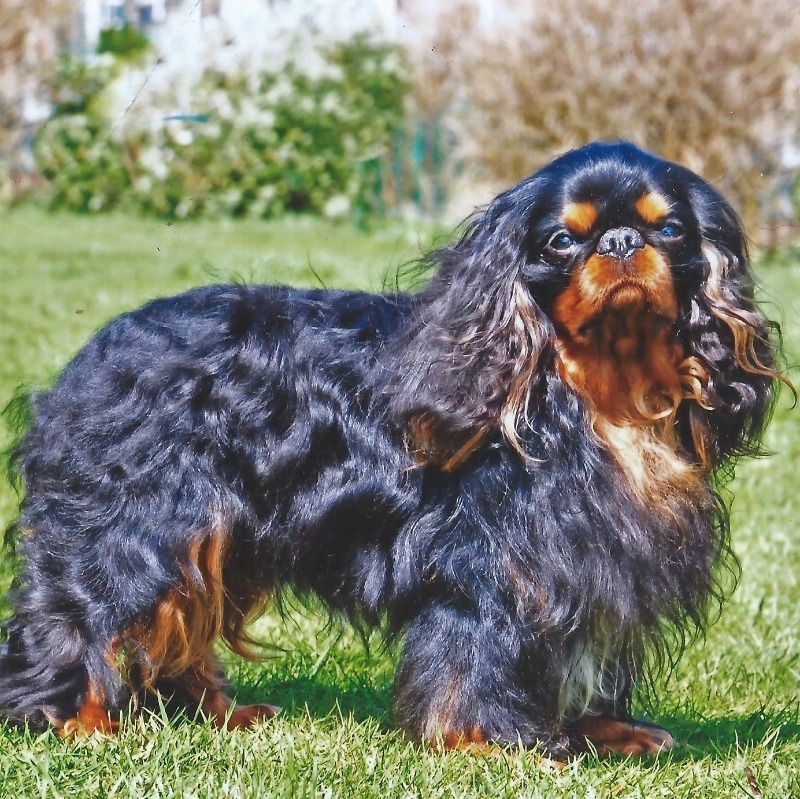Breeds
King Charles Spaniel

GROUP 1 - TOYS
Brief History
Also known as Charlies, The Spaniel Gentle, The Royal Spaniels, or simply The King Charles, this little dog’s origins are lost in the complexities of politics and marriages of royalty, merchants, knights and adventurers. Their journey, just from where we do not really know, is a romance. In England, Henry VIII decreed that his court ladies could carry small spaniel type dogs. However, it was the ‘Merry Monarchs’, Charles I and II who immortalised these toy spaniels as symbols of the House of Stuart where is was decreed that these miniature spaniels be the only dogs admitted in the Houses of Parliament.
The dog fraternity in Victorian times witnessed an obsession with Asian toys; it is likely that Pugs and Japanese Chin were crossed with these spaniels to produce a dog with a more domed skull and a flatter face than the dogs of the Stuarts. The King Charles Spaniel of course is the original prototype, whilst the more contemporary Cavalier was an attempt to return the breed to his ancient appearance.
Average Life Span
When considering a dog, please realise that you are taking it on for its lifetime.
The average life span is 10 to 14 years.
Temperament
Like many toy breeds kept by royals, King Charles Spaniels came to assume the personalities of their aristocratic owners. They can be proud and wilful, and extremely discriminating in their choice of friends. With their favoured humans, they are affectionate at home and exuberant and curious at play. An unfair assumption is to believe the King Charles will have the demonstrative demeanour of his more numerically popular larger cousin the Cavalier. For two breeds that share so much in common, their temperaments and view of the world could not be more different.
General Breed Description
The King Charles Spaniel is a refined, cobby, toy dog endowed with a short nose, domed skull and low set long lavish ears and a silky, flowing coat which comes in four colours: black and tan, red and white (Blenheim), white, black, and tan (tricolour) and a solid red (ruby). His sturdy body, regal and charming temperament, together with his lustrous dark eye, and well cushioned face, proclaim him a dog of distinction and character.
Coat and Care Requirements
The King Charles Spaniel’s long, wavy, silky, and profuse coat should be brushed at least twice a week with a pin brush or soft bristle brush. A long-toothed metal dog comb can also come in handy for gently working through areas where tangles may be beginning to form. Left unattended, tangles and mats are uncomfortable for your dog and can cause skin problems to develop. A bath every few weeks will see the King Charles Spaniel’s coat and skin clean and healthy. Grooming sessions are a good time to check the dog all over for any new lumps or skin problems, and to check that the eyes and ears are healthy and trouble free.
Size
Weight: 3.6 to 6.3kgs.
Health
All breeds have individual health issues. When speaking to breeders it is recommended you enquire about the breed’s health and what health testing the breeder does. The King Charles Spaniel is generally a healthy breed; however, health conditions do occur occasionally. These may include eye conditions, cardiac disease and luxating patellas. Dedicated breeders test their breeding stock and communicate with each other regularly to work together for breed health and preservation of the breed’s unique qualities. The King Charles Spaniel’s ears should be checked regularly for signs of infection, and the teeth should be brushed often, using a toothpaste designed for dogs.
Suitability
King Charles Spaniels are moderately active; when outdoors exercising they are alert, playful, and energetic, whilst at home they are sedate and dignified. They are easy going dogs who make excellent companions for city dwellers in small apartments who can provide the dogs with daily walks on lead. As a short-faced breed, the King Charles is not appreciative of hot weather and should not be left outdoors on overly warm or humid days. They are far more suited to a serene and gentle household than a boisterous one. His cousin the Cavalier is the extrovert, the King Charles the introvert.
In Conclusion
Now you know a little more about this breed. If you have decided this is the dog for you and wish to investigate further, please contact the Breed Club or Dogs Victoria. They will be able to give you information about available puppies and also suggest dog events where you can see the breed and speak to breeders. In this way you will gain a better perspective of the breed and its needs. With any breed of dog, it is important to research and determine suitability for your lifestyle before committing to a puppy which will be a part of your family for many years to come.
Whilst many breeds are recommended for families, it is imperative that when children are with dogs they are supervised at all times. Basic obedience training is a vital part of dog ownership.
Dogs Victoria is about the responsible ownership of all dogs and in particular the preservation of pure breeds.
Link to Dogs Australia Breed Standard: https://dogsaustralia.org.au/breed/detail/26
Breeders
Sorry, there are currently no breeders advertising for this breed. If you are a registered Dogs Victoria breeder and wish to advertise here please create an advertisement here.


